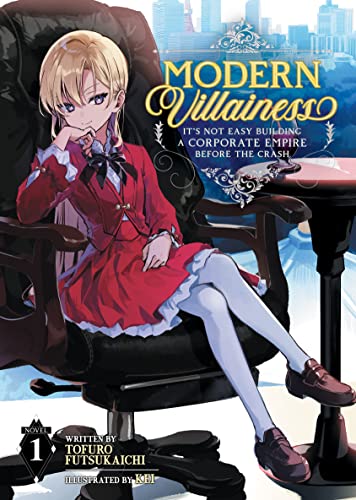By Tofuro Futsukaichi and Kei. Released in Japan as “Gendai Shakai de Otome Game no Akuyaku Reijou wo Suru no wa Chotto Taihen” by Overlap Novels. Released in North America by Airship. Translated by Emma Schumacker. Adapted by Jack Hamm.
I want to be more mad at this series than I am. It’s ludicrously pro-capitalism and pro-cop. Our heroine builds gated communities for people in the previous book, then in this one seems to be absolutely shocked that racism exists in the United States. The bulk of the middle third of this volume involves her trying to prevent 9/11 from happening. She fails. But then you also see that 9/11 has been enhanced by a deadly nuclear train almost wiping out Denver, and you think to yourself, “Wasn’t that the movie Atomic Train?”, and you realize that the author really does not have a hidden message or meaning to this book at all. It’s not trying to use its heroine to show you that right-wing politics is good, actually. It’s an author playing with toys, and when there’s a section of the plot where, say, you can work in a Tom Clancy book’s plot, in it goes. It’s hard to get mad at a Tinkertoy novel.
Even the author admits that this volume’s “plot” is scattered. It’s basically events that happen before and after Runa’s 10th birthday. This includes the aforementioned 9/11, which happens DURING Runa’s birthday party. We get school adventures, like Runa doing sports and club activities, and also a mountain climb and a trip to Kyoto. We also get more of Runa being the hidden power behind most of Japan, and start to see the beginnings of a rift between her and Prime Minister Koizumi. But other people are finally beginning to realize that this little girl has her fingers in a LOT of pies, and they’re trying to stop her. Not necessarily for reasons of “I want to control what she has”, but also for upright reasons like “this 10-year-old girl is killing herself trying to do everything”. How much longer can Runa get away with this?
I was very amused at the new character in this book, a “high roller” type who, like most of the capable people in this world, ends up becoming one of Runa’s employees. Unlike the rest of her staff, who likely realize something is wrong but don’t say anything out of politeness, he straight up asks Runa how the hell she is doing this. Runa still has not quite admitted “I’ve been reincarnated into an otome game”, but there’s just no way to accept any of her decisions without thinking that she has supernatural powers. Hell, her friend Hotaru has them, why not Runa? As for Runa herself, I think the book’s weak point remains her “villainess” part of it. She seems torn to the point of tears about whether she can change her fate, but she’s not trying to make herself a better person, she’s just trying to make sure her financial empire is not ruined. She’s still sort of evil. Work on that.
I don’t really recommend this series to anyone but economics majors, but I still find it rather fascinating in a morbid way. The webnovel version of this has 11+ books of material, but the 4th volume is the latest published in Japan, so we’re mostly caught up.



